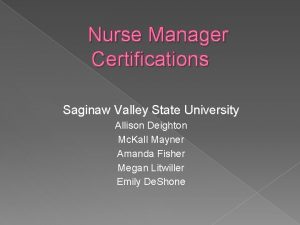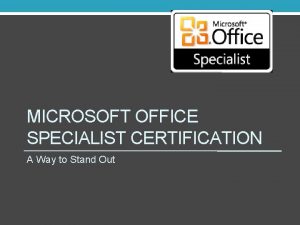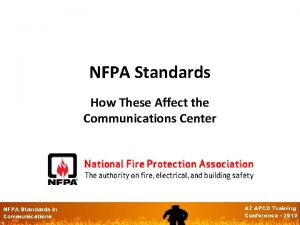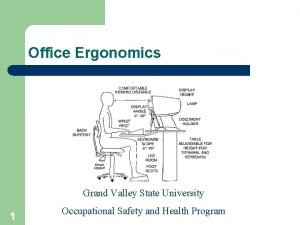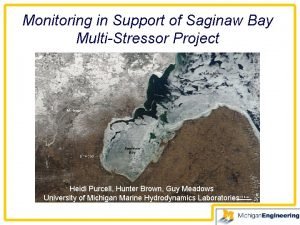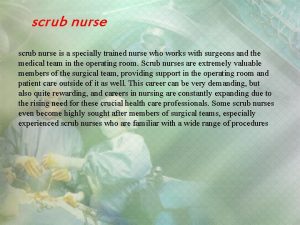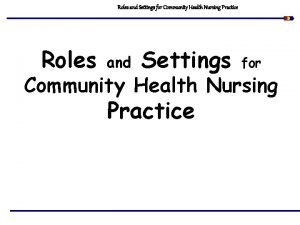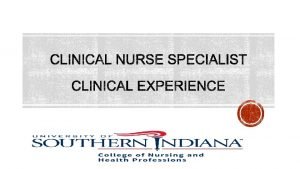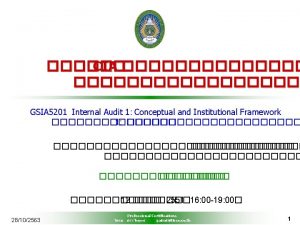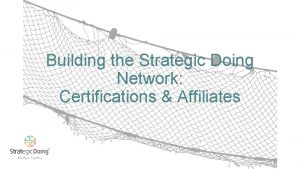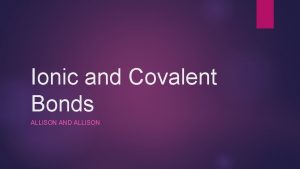Nurse Manager Certifications Saginaw Valley State University Allison













- Slides: 13

Nurse Manager Certifications Saginaw Valley State University Allison Deighton Mc. Kall Mayner Amanda Fisher Megan Litwiller Emily De. Shone

Certified Nurse Manager and Leader Credential (CNML) A collaboration between the American Organization of Nurse Executives Credentialing Center (AONE) & the American Association of Critical Care Nurses (AACN). • CNML certification gives nurse managers a way to validate their knowledge as they strive to excel in their demanding roles, carrying out complex leadership responsibilities that directly affect the quality of care to patients and families. • 24 -hour clinical and administrative accountability for their unit (American Association of Critical Care Nurses)

NEA-BC: Nurse Executive Advanced – through ANCC. › The ANCC Nurse Executive board certification examination is a competency based examination that provides a valid and reliable assessment of the entry-level clinical knowledge and skills of the nurse charged with the managing the daily operations of a unit or service line. › Once you complete eligibility requirements to take the certification examination and successfully pass the exam, you are awarded the credential: Nurse Executive Advanced-Board Certified (NEA-BC). (American Nurses Credentialing Center) › The key roles of nurse executives include facilitating the design of patient care delivery; advancing the discipline of nursing; building relationships and connections with staff and colleagues; and fostering stewardship. (American Organization of Nurse Executives)

American Organization of Nurse Executives (AONE) Founded: 1967 Mission: “To shape health care through innovative and expert nursing leadership” Vision: “Global Nursing Leadership—One Voice Advancing Health” Functions of AONE: • -“Providing vision and actions for nursing leadership to meet the health care needs of society. ” • Influencing legislation and public policy related to nursing and patient care issues. • Offering member services that support and enhance the management, leadership, educational and professional development of nursing leaders. • Facilitating and supporting research and development efforts that advance nursing administration practice and quality patient care. ” (American Organization of Nurse Executives, 2014)

Educational Preparation NEA-BC • Hold a current, active RN license within the United States • Hold a master’s degree in nursing, or hold a bachelor’s degree in nursing and a master’s in another field • Have held an administrative position at the nurse executive level or a faculty position teaching graduate students executive-level nursing administration full-time for at least 24 months in the last 5 years • Have completed 30 hours of continuing education in nursing administration within the last 3 years. This requirement is waived if you hold a master’s degree in nursing administration CNML • Hold a valid, unrestricted license as a RN in the United States • BSN or higher • 2 years of experience in a nurse manager role • Or… • a non-nursing bachelor’s plus 3 years of experience in a nurse manager role • Or… • Diploma or Associates degree plus 5 years of experience in a nurse manager role.

Certification Agency AONE/AACN (CNML) ANCC (NEA-BC) Eligibility Criteria *Current, active, and unrestricted RN license *BSN degree or higher plus 2 years of experience in a nurse manager role OR a non-nursing bachelor’s degree plus 3 years of experience in a nurse manager role OR a diploma or associate degree plus 5 years of experience in a nurse manager role *Current, active RN license in US *Master’s or higher degree in nursing OR BSN and master’s in another field *Have held an administrative position or faculty position at nurse executive level *Completed 30 hours of CEU in nursing administration Application Process Read eligibility requirements, apply online, provide final degree conferred transcripts. Read eligibility requirements, complete a paper or online application through AMP, Inc. Test Preparation Free and paid study aids include a CNML handbook, essentials review course, e-Learning, and self assessment exam. Website Free and paid study aids include webinars, seminars, practice test questions and online test content. www. aone. org/resources/certification www. nursecredentialing. org/Nurse. Exe /about_certifications. shtml#cnml cutive-Advanced

Creating a Healthy Workplace. Radiology Nursing Staff Use the HWE Assessment Tool to Improve the Work Environment. AACN Healthy Work Environment Assessment Tool was used in a radiology department that was undergoing change and increased stress ⦿ HWE is used to address specific unit’s work environment ⦿ HWE Standards ⦿ › › › ⦿ Skilled communication True collaboration Effective decision making Appropriate staffing Meaningful recognition Authentic leadership By Identifying the strengths of the unit the environment was “much improved”. The major areas of improvement are in communication, workflow processes, and developing a better sense of team.

Leadership agenda for change toward healthy work environments in acute and critical care. Purpose: Describing ways to work towards a healthy work environment Design: Peer-reviewed Clinical Journal Findings: ⦿ AACN made a commitment to promote the creation of healthy work environments. ⦿ Healthy environments are known to contribute to excellent patient care. ⦿ Main strategies for building healthy work environments: ⦿ Encourage nurse managers to become certified in nursing administration ⦿ Provide ongoing career and leadership development opportunities ⦿ Develop nurse managers’ expertise in financial management ⦿ Evaluate governance structures to ensure that nurses are allowed shared decision making ⦿ Evaluate unit based performance improvement practices ⦿ Implement use of technology that aid in the effectiveness of care delivery. ⦿ Design better decision making models Shirey & Fisher, 2008

Growing Future Nurse Leaders to Build and Sustain Healthy Work Environments at the Unit Level • Purpose: Describe how to achieve a health work environment via nurse leaders • Design: Literature Review • Leading findings: “The establishment of a healthy work environment requires strong nursing leadership at all levels of the organization, but especially at the point of care or unit level where most front line staff work and patient care is delivered. ” • (Sherman & Pross, 2010, p. 1) The Nursing Organizations Alliance’s nine key elements that support the development of a healthy work environment: 1. A collaborative practice culture 2. A communication rich culture 3. A culture of accountability 4. The presence of adequate numbers of qualified nurses 5. The presence of expert, competent, credible, visible leadership 6. Shared decision making at all levels 7. The encouragement of professional practice & continued growth/development 8. Recognition of the value of nursing’s contribution 9. Recognition by nurses for their meaningful contributions to practice

Nurses’ self-efficacy and academic degree advancement Purpose: To evaluate the relationship between selfefficacy and advancing academic aspirations of registered nurses ⦿ Design: Review of Literature; non-experimental, correlational design ⦿ Findings indicated that self-efficacy of nurses who began their career with a diploma or associate degree and went on for academic advancement was higher than those who did not. ⦿

Certification, Empowerment, and Intent to Leave Current Position and the Profession Among Critical Care Nurses ⦿ Purpose: To determine the relationship between specialty certification and empowerment and to evaluate the value of AACN specialty certifications ⦿ Design: Survey ⦿ AACN certified nurses had significantly higher empowerment scores than did nurses not certified. ⦿ Nurses with AACN certification were less likely to leave their position and had higher job satisfaction. (Fitzpatrick, J. , Campo, T. , Graham, G. , Lavandero, R. , 2010)

Literature Summary Nurses with AACN certifications have higher selfefficacy, more self-empowerment, and higher job satisfaction. ⦿ The AACN is working hard to create healthy work environments by conducting the HWE Assessment in numerous health care nursing units. Based on their findings, they encourage nurse managers to become certified, provide ongoing developmental opportunities, and continuously evaluate performance of the individual nurses and the unit as a whole. ⦿ 12

References American Association of Critical-Care Nurses. (2014). Certification for nurse managers and leaders. Retrieved from http: //www. aacn. org/wd/certifications/content/cnmlhome. pcms? menu=certification American Nurses Credentialing Center. (2014). Nurse executive, advanced. Retrieved from http: //www. nursecredentialing. org/Nurse. Executive-Advanced American Organization of Nurse Executives. (2014). Nurse executive. Retrieved from http: //www. nursesource. org/executive. html AONE Credentialing Center. (n. d. ). AONE. Retrieved July 29, 2014, from http: //www. aone. org/resources/certification/about_certifications. shtml Blake, N. , Mills, M. , & Guerrero, V. (2012). Creating a Health Workplace. Radiology Nursing Staff Use the HWE Assessment Tool to Improve the Work Environment. AACN Advanced Critical Care, 23(2), 128 -132. Nurse Executive, Advanced Certification Eligibility Criteria. (n. d. ). Nurse Executive, Advanced Certification Eligibility Criteria. Retrieved July 29, 2014, from http: //www. nursecredentialing. org/Nurse. Exec. Adv-Eligibility. aspx Fitzpatrick, J. J. , Campo, T. M. , Graham, G. , & Lavandero, R. (2010). Certification, empowerment, and intent to leave current position and the profession among critical care nurses. American Journal of Critical Care, 19(3), 218 -226. Sherman, R. , & Pross, E. (2010). Growing future nurse leaders to build and sustain healthy work environments at the unit level. Online Journal of Issues in Nursing, 15(1), 1 -12. Shirey, M. , & Fisher, M. (2008). Leadership agenda for change toward healthy work environments in acute and critical care. Critical Care Nurse, 28(5), 66. Winslow, S. , De. Guzman, P. , Kulbok, P. , & Jackson, S. (2014). Nurses’ self-efficacy and academic degree advancement. Journal for Nurses in Professional Development, 30(3), 110. doi: 10. 1097/NND. 000000038
 Saginaw valley state university nursing
Saginaw valley state university nursing Do microsoft office specialist certifications expire
Do microsoft office specialist certifications expire A-192
A-192 Cahims exam questions
Cahims exam questions Omwbe certifications
Omwbe certifications Nfpa 1061
Nfpa 1061 Grand valley occupational medicine
Grand valley occupational medicine Fort valley state university dorm tour
Fort valley state university dorm tour Saginaw city sonar
Saginaw city sonar Mount allison university bookstore
Mount allison university bookstore Scrub nurse duties
Scrub nurse duties A nurse preceptor is orienting
A nurse preceptor is orienting Role of community health
Role of community health Senior manager vs general manager
Senior manager vs general manager
